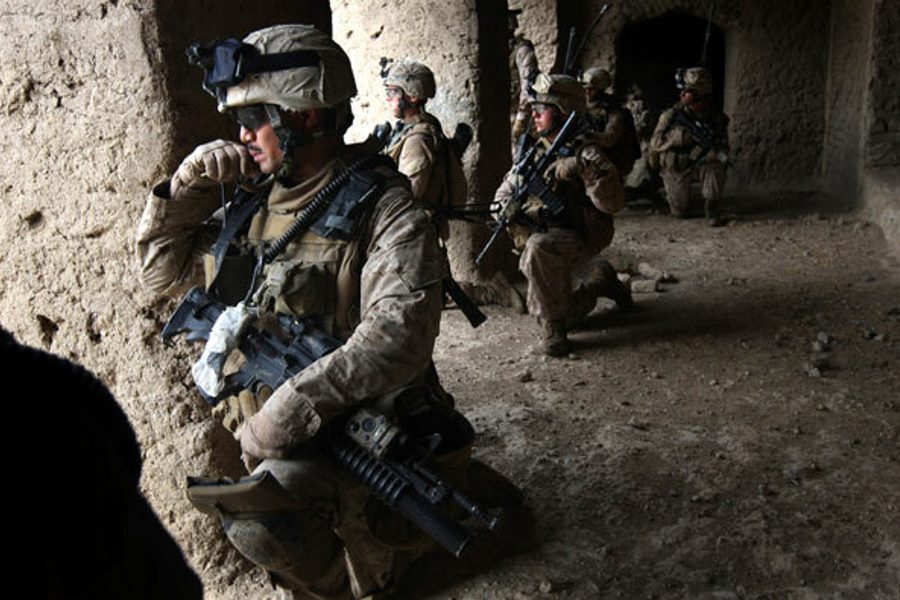COIN Toss
Counterinsurgency failed before, but the United States is trying again.
Jordan Michael Smith

General David Petraeus, commander of U.S. forces in the Middle East and South Asia, is known to Americans primarily as the architect of “the surge,” the increase in U.S. troops in Iraq in 2007.
But he is equally influential in military circles for his promotion of counterinsurgency (COIN) strategy, of which the surge was only one manifestation. At Washington’s posh Willard InterContinental Hotel on June 11, with 1,400 pairs of ears in the audience, Petraeus declared, “Counterterrorism actually requires a counterinsurgency approach.”
A COIN campaign is defined by the U.S. Army as a mix of offensive, defensive and stability operations conducted according to the situation and mission. Counterinsurgents employ a mix of familiar combat tasks and skills more often associated with nonmilitary agencies, such as establishing civilian institutions and building basic services. COINdinistas, as boosters like Petraeus are known, argue that counterinsurgency eschews the brutality of traditional warfare, and is a viable strategy for the United States in the 21st century.
In reality, however, COIN presents grave dangers to the United States. It is an enormously burdensome approach, extracting troops and money out of a country that has recently expended too much of both. Even more worrisome, the military’s elevation of COIN to the level of doctrine will further fuel the military-industrial complex, making war a more attractive and likely option in the future.
Reviving failure
COIN is not new, and neither are the worries associated with it. In the United States, it first emerged as an intellectual force in the 1960s, as planners looked for a way to defeat the North Vietnamese. Military experts examined the British struggles against anti-colonial uprisings in Kenya and Malaysia and tried to apply their lessons to Southeast Asia. But after the defeat in Vietnam, the military rejected COIN, determined to never again get involved in protracted, asymmetrical combat in foreign lands. “It is embarrassing how little irregular warfare was taught within the services after Vietnam,” concedes Roger Carstens, an Army Special Forces veteran and a senior fellow at the Center for a New American Security.
COIN was unexpectedly resurrected in 2003, when the Iraqi insurgency erupted in the wake of the initial U.S. invasion. Despite then-Secretary of Defense Donald Rumsfeld’s multi-year denial of the insurgency’s existence in Iraq, the military saw what it was facing and began to revive COIN. “It was strictly out of necessity,” says Michael Mazarr, a professor of national security strategy at the National War College.
Though the military may have adopted the strategy reluctantly, its embrace of COIN is now comprehensive and ongoing. In his April budget recommendations, Secretary of Defense Robert Gates signaled his priorities by requesting that Congress transfer money away from future, expensive weapons systems to weapons and troops applicable to the wars in Afghanistan and Iraq. This new focus has required a comparable shift in strategy.
For eight years, since the 2001 invasion, the United States spent approximately $45 million annually to support the eradication of poppies in Afghanistan, a major source of income for insurgents. But now, seeing that poor Afghan farmers depend on the poppies for their livelihood – and that efforts to stamp them out have failed – the United States is abandoning eradication as a goal. “The real difference as we move from how we were focusing on Afghanistan in the past [to] the president’s new focus on counterinsurgency is that this is a policy that defines the strategic interest, that defines winning over the population” as the primary goal, Deputy Assistant Secretary for Counter-Narcotics and Global Threats William Wechsler told the Associated Press. Officials have also reportedly told allies that the United States will boost funding for alternative agriculture from tens of millions of dollars annually to hundreds of million. The Obama administration sent agronomists to Afghanistan this summer to beef up its civilian efforts.
But it doesn’t seem to be enough. Generals in Afghanistan told National Security Advisor James Jones in June that they needed thousands more troops to fight the Taliban insurgency. One senior military officer told the Washington Post that at least 32,000 more troops will be required to maintain areas and towns after they are cleared of Taliban insurgents. General Stanley McChrystal, the American commander in Afghanistan, has declined to say whether he would recommend expanding American combat forces or increasing the number of military trainers, but he has not ruled it out either. President Obama, however, has openly said, “My strong view is that we are not going to succeed simply by piling on more and more troops.”
COINdinistas would concede that Obama is correct – no counterinsurgency can be won by large troop numbers alone. But high troop levels are needed to protect a population, according to COIN theory. Contra Obama, hundreds of thousands of troops are not sufficient to effectively fight a counterinsurgency – but they are necessary. The 2006 U.S. Army/Marine Corps Counterinsurgency Field Manual, co-written by Petraeus, suggests that force size be calculated in relation not to the opponent, but to inhabitants. The manual recommends a minimum of 20 counterinsurgents per 1,000 residents. In Afghanistan, with its population estimated at 33,000,000, that would mean at least 660,000 troops – a number far greater than the 68,000 that will be stationed there by year’s end.
War as a solution
Implementing a fully realized COIN strategy, in Afghanistan and elsewhere, requires the United States to occupy foreign nations for years, even decades. COINdinistas are often the first ones to say gigantic resources are required, Mazarr says. According to the field manual, “By its very nature, insurgency is protracted. The conduct of counterinsurgency always demands considerable expenditures of time and money.” The United States is unlikely to be willing to put in that time and money often, if ever. And fighting a war halfheartedly is the surest way to lose one.
Most problematic of all, faith in the efficacy of COIN might encourage the United States to go to war more often, a menacing prospect for a country already unnecessarily engaging in wars. As the military becomes more adept at occupying and pacifying foreign countries, war will appear more attractive to policymakers and the American public. “COIN promotes a mindset that tends to view failed states as a problem that can be solved by American military power,” Mazarr says. “A crisis in a failing state, or an emergency, could attract the U.S. to intervene in places we shouldn’t.” Moreover, as the military gets more training, operations, equipment and cultural training, senior officers are likelier to become persuaded that they can more easily rebuild foreign countries, Mazarr says. Andrew Bacevich, professor of international relations at Boston University, argues that the United States has never needed COIN to intervene overseas, but he says that “to the extent the officer corps is convinced they have the formula to nation-build, senior military officers will come to the Department of Defense believing” they can solve nearly any international problem.
COIN indoctrinated
COIN undoubtedly has something going for it: It seems a more humane method of fighting than traditional warfare. Because it revolves around securing the consent of the population, it calls for using little brutality. In fact, the strong use of force is usually counterproductive to effective COIN implementation, since it alienates the very population needed for success. “An operation that kills five insurgents is counterproductive if the collateral damage or the creation of blood feuds leads to the recruitment of fifty more,” reads the field manual.
There is also little doubt that COIN has been effective in Iraq, in driving down both American and Iraqi casualties. To the extent that it assists in rebuilding shattered nations, and encourages the U.S. military to prioritize civilian safety when doing so, it is valuable. “It gives policymakers another tool with which to combat national security threats,” Carstens says.
Nonetheless, these benefits seem small in proportion to the costs of COINing the military. But in any case, the institutionalization of COIN is already a fact. “[T]he foreign policy establishment and military have leapt aboard the COIN bandwagon as uncritically as many of them once supported tank warfare,” says Ann Marlowe, who has reported frequently from Afghanistan and is working on a book about COIN’s origins.
The theory is taught at all U.S. war colleges, and military personnel are trained in COIN at all levels. Even if COIN were somehow erased from military doctrine tomorrow, a generation of servicemen and women will have internalized its principles. COIN was revived as a way to fight insurgents in Iraq. But its emergence may haunt U.S. foreign policy for decades to come.








